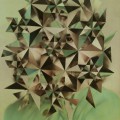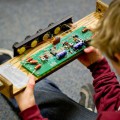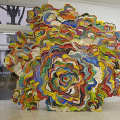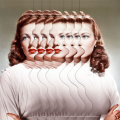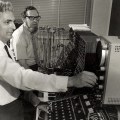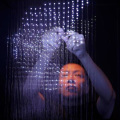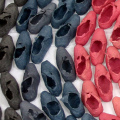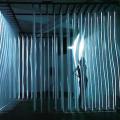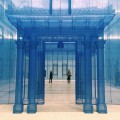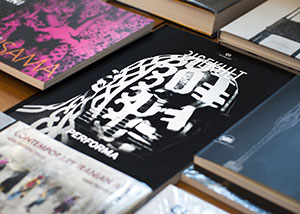For The ADA Project, four renowned female musicians created works in response to the movements of an industrial robot that has been hacked and programmed by the artist Conrad Shawcross to create four unique choreographies. In this first-of-its-kind collaborative artwork, Shawcross takes a new approach to commissioning music, reversing the traditional process, so that the robot’s dance provides the inspiration and parameters for the music. For this piece Shawcross found inspiration from Ada Lovelace (1815-1852) the mathematician (and daughter of Lord Byron). Working alongside Charles Babbage, inventor of the first proto-computer, Lovelace predicted that this complex counting machine “might compose elaborate and scientific pieces of music of any degree of complexity or extent”, pre-empting the birth of programmed music by more than a century. The musicians, all of whom use electronic programming in their work, worked closely with Shawcross in his studio discussing Babbage and Lovelace’s discoveries, and studying the robot as it played out one of four programmed patterns created by the artist. Each distinctive pattern is based on ratios and drawings for the computer which Babbage never fully realised, a fact that provides added significance to the programming that depicts them and the computer generated music which they inspire. From this fertile source of inspiration, the compositions have grown in broadly different ways: Beatrice Dillon in collaboration with Rupert Clervaux uses the robot as percussion, sampling rhythms played on different parts of its housing. This was edited with field recordings of the engine, the vibration of the tripod legs and the tonal resonance of the machine’s metal parts. Using a combination of vocal processing, synthesis and recordings of the robot in motion, Holly Herndon attempts to emote the sentience implied in the robot’s movements as she curiously probes and surveys her environment. For her composition titled If Then While For Mira Calix creates a narrative lament in which soprano Teresa Duddy sings to the robot, willing it to fall in love with her. The machine’s movement of languid strokes suggests that it reciprocates her overtures. Songwriter and vocalist Tamara Barnett Herrin (Freeform Five) backed by DJ / Producer Mylo, sings Ada, Make a Bed For Your Phoenix, which links mathematics with disco through their shared power to induce ecstatic states. Each composition has been pressed by The Vinyl Factory as one of four limited edition laser etched 12” vinyl records, each accompanied by one of four artist’s prints, hand signed and numbered by Conrad Shawcross. The singles alone are also be available as a larger edition. The ADA Project was originally conceived for Palais de Tokyo, Paris with curator Ken Farmer. Conrad Shawcross (b 1977) explores subjects that lie on the borders of geometry and philosophy, physics and metaphysics. Attracted by failed quests for knowledge in the past, he often appropriates redundant theories and methodologies to create ambitious structural and mechanical montages. Recent solo presentations include: the Palais de Tokyo, Paris (2013); MUDAM, Luxembourg (2012); Science Museum, London (2011-2012) and Turner Contemporary, Margate (2011). His work has also been exhibited internationally at institutions and events including the 55th Venice Biennale (2013); Grand Palais, Paris (2013); Hayward Gallery, London (2013) and KW Institute for Contemporary Art, Berlin (2012). In 2012 Shawcross, along with Chris Ofili and Mark Wallinger, was invited to create works inspired by Titian’s masterpieces for the project Metamorphosis: Titian 2012, an ambitious collaboration with the National Gallery and Royal Ballet for the Cultural Olympiad. Timepiece was a major new commission for the Roundhouse in 2013 in which the artist transformed the iconic main space of this historic London building into a vast timekeeping device.
Conrad Shawcross: The ADA Project
CREDITS: www.thevinylfactory.com
LINK: www.conradshowcross.com
COMMENTSRELATED POST |
|
|
|
|




















